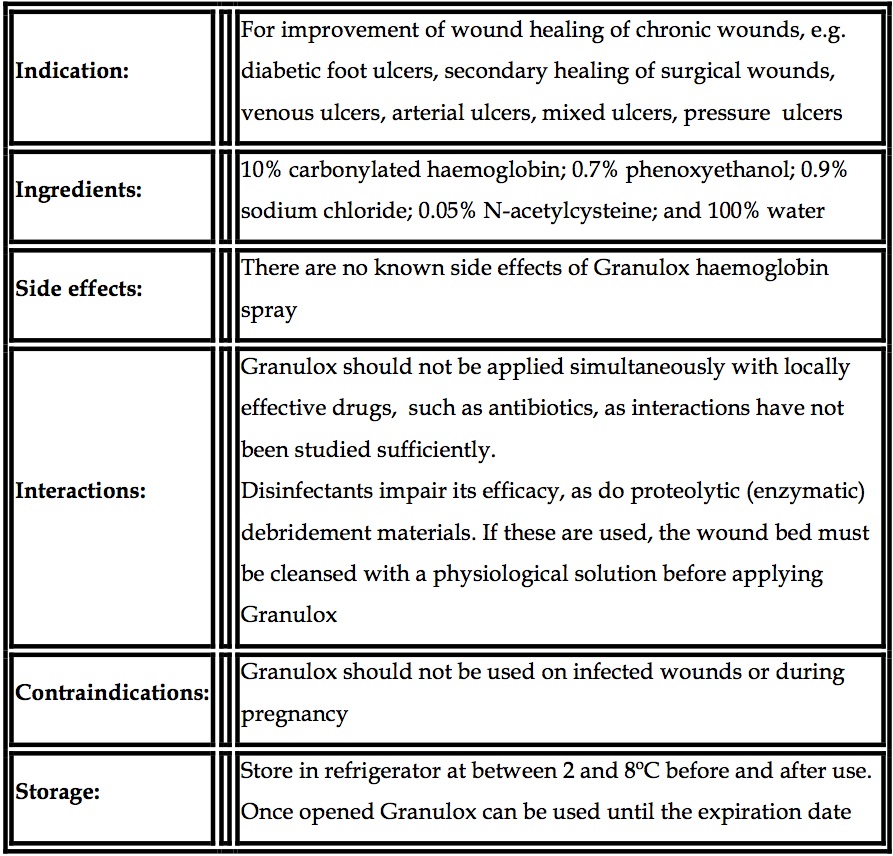Granulox Haemoglobin Spray
Deborah Glover - Editor PCNR
BSc (Joint Hons), Dip. Care Policy & Management, RGN
Oxygen in chronic wound healing
Physiological wound healing is a well-regulated process that ends with wound closure within days or weeks, depending on diameter and depth of the wound. Oxygen is required for almost every step of healing [1]; tissues require high oxygen levels to defend against pathogens such as the formation of reactive oxygen species (ROS) which may damage cells, and to meet increased metabolic demand [2].
In chronic wounds, tissue hypoxia (oxygen deficiency) is a common aetiology in healing disorder, particularly in patients with peripheral occlusive arterial disease, chronic venous insufficiency or diabetes [2].
Clearly, management of such chronic wounds requires that any underlying aetiology affecting healing is addressed, and that other oxygen delivery systems such as hyperbaric and topical treatments are considered.
Topical oxygenation
Studies reported during the last five years have renewed interest in examining the significance of topical approaches to oxygenate cutaneous wounds as adjunctive therapy [3]. However, getting topical oxygen into the wound bed is challenging; wound exudate is necessary for moist wound healing, but it creates a diffusion barrier. Therefore, how do you deliver an appropriate therapeutic dose to the wound?
Barnikol et al [4] suggested using an aqueous solution to deliver oxygen mediators such as haemoglobin. This facilitates free diffusion of oxygen.
Granulox
Granulox (Infirst Healthcare) is an innovative haemoglobin spray which improves the oxygen supply to chronic wounds through simplified diffusion, thereby promoting wound healing. Granulox is distributed into the wound bed, where the haemoglobin binds oxygen from the surrounding air and transports it to the wound bed where it diffuses into the cells.
Its effectiveness has been proved in a number of clinical studies. Arenberger et al [5] used data from a clinical trials, treatment observations and single patient uses of Granulox to determine its efficacy and safety. The total number of patients treated in the studies they reviewed was 82 (2,000 applications of Granulox). In all cases, the spray was well tolerated and there were no adverse events. Outcomes included:
- data from a clinical study in Mexico and subsequent therapy observations which showed that in 39 of 42 patients (93%), the treated wounds healed
- a further nine patients from a series of observations in Monterrey (Mexico), which showed that all treated wounds were closed
- a single patient use case series undertaken in Germany; healing achieved in 75% of wounds (n=8)
- a single patient use case series undertaken in Prague; healing achieved in 100% of wounds (n=5)
- a single patient use xase series undertaken in the Czech Republic; healing achieved in 100% of wounds (n=5)
From the results of these studies, Arenberger et al [5] concluded that the application of the haemoglobin spray promoted wound healing.
Arenbergerova et al [2] undertook a prospective, randomised, single-blind study to determine the effect of Granulox on the healing of venous leg ulcers over a 13-week period, comparing it to a control group who did not receive Granulox. Both arms received only standard care. Spray was applied to the wounds in the Granulox group after cleansing and disinfection (standard care), followed by a thin, air-permeable nanofibre dressing. Compression therapy was commenced two weeks before the start of the study and continued during the study period.
Seventy-two patients (thirty-six patients in each arm) were recruited (64% female, 36% male). All were over 18 years of age, had a venous leg ulcer (minimum size 1.6cm2, maximum wound surface area 50cm2), which had been present for more than eight weeks. Ankle-brachial pressure index had to be more than 0.8 to preclude arterial disease.
Results showed a mean reduction in wound surface area of 53.4% (p<0.0001) in the Granulox group (group 1) and a mean enlargement (17.5cm2 to 20.2cm2) in the control group (group 2). Other parameters were studied; group 1 showed a 48% reduction in necrotic tissue and an increase in granulation tissue of 72%, compared to 17% and 18% respectively in group 2. In addition, pain intensity (using a visual analogue scale) decreased by 64% (p<0.01) in group one, and 6% (p0.05) in group 2 (Figure 1).

How to use
As with any wound therapy, any co-morbidities which may affect healing should be addressed. In addition, excess wound exudate and/or infection must be removed before using Granulox as part of the wound management plan. The wound should be cleansed as normal and the spray applied, followed by a thin, nanofibre wound dressing which is permeable to air. The haemoglobin contained in the spray supplies the tissue at the wound bed with oxygen over a long period of time through diffusion (Figure 3).
Patients should not be allergic to any of the spray’s contents or animal proteins. Optimally, wounds should not exceed 35 cm2, but their depth may reach deeper than the papillary dermis.
Conclusion
Granulox haemoglobin spray has been proven to accelerate chronic wound healing in a variety of wounds. It is simple to use, and is clinically and cost effective. Further studies are underway; results will be presented at professional meetings and in journals in due course.
Further information can be obtained at: http://www.infirst.co.uk/


























